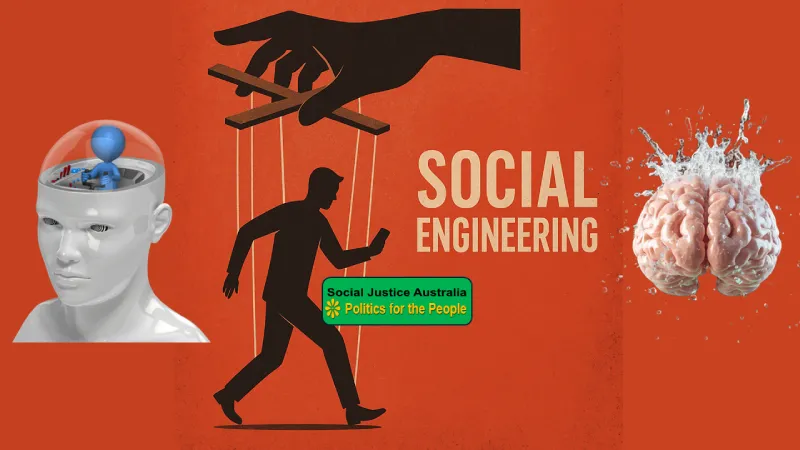Description
Discover how we’re conditioned through social engineering—and how you can break free and reclaim your autonomy.
Conditioned by Design: How Social Engineering Shapes Our Lives
Introduction: A Silent Influence We Never Noticed
Picture this: You’re watching the nightly news. A politician warns about the dangers of growing public debt. The anchor nods in agreement. Ads cut in—telling you to buy now, save later. You feel a twinge of guilt about needing government help, but don’t question why housing, healthcare, or education is so expensive in a country with sovereign control of its currency.
You’ve just been socially engineered.
This article explores the invisible hand behind many of our beliefs. From school systems to media narratives, social engineering is everywhere. It doesn’t always wear a villain’s mask—but its consequences shape our society in profound ways.
What Is Social Engineering?
Beyond Password Hacking: A Broader Definition
Social engineering is more than scams or phishing emails. It’s the use of psychological manipulation by governments, corporations, media, and institutions to shape public beliefs, values, and behaviours—often without consent.
Australia’s Landscape of Influence
• Education systems that discourage critical thinking in favour of obedience.
• Media conglomerates pushing corporate agendas while silencing dissent.
• Think tanks and lobby groups creating the illusion of consensus.
Each of these pillars subtly rewires public thinking—nudging citizens into accepting inequality, consumerism, and apathy.
How Have We Been Conditioned?
Story 1 – The Classroom as a Control Mechanism

In 1975, a Queensland boy questions his history teacher: “Why did we take land from Aboriginal people?” The class falls silent. He’s told not to challenge the curriculum.
This was not an isolated moment. The education system has long served to preserve status quo thinking (conditioning). Students are taught to memorise—not question. National myths are prioritised over uncomfortable truths.
Story 2 – Media as a Megaphone for the Powerful
In 2023, 90% of Australia’s print media is controlled by two companies. News stories are framed to prioritise economic growth over environmental degradation, and politicians are rarely asked hard questions—unless it serves elite interests.
Media becomes less about informing and more about reinforcing the existing order.
Story 3 – Normalising Corporate Control Through Advertising
Billboards urge Australians to take out loans for SUVs, use AfterPay for basics, and feel shame for being unemployed. In the background, marketing budgets soar while wages stagnate.
We’re trained to feel we are the problem, not the system that manufactured our insecurity.
Language as a Weapon
Phrases like “taxpayer money” or “leaning on the state” obscure truth. They reinforce myths that federal budgets are like household budgets—ignoring Australia’s dollar sovereignty.
Who Benefits From This Conditioning?
Real-World Examples of Social Engineering in Australia
Australian governments and corporations have repeatedly used social engineering to manage public opinion and control narratives:
Media framing: In 2010, Australia’s proposed internet censorship was framed as child protection, leading to public pushback and cyberactivism (Wikipedia).
Behavioural nudging: The use of ‘nudge theory’ in policymaking subtly influences decisions without direct mandates (More Than Digital).
Language manipulation: Terms like “taxpayer money” obscure Australia’s currency sovereignty, conditioning the public to accept austerity.
Corporate lobbying: Fossil fuel and gambling industries heavily influence policy via donations and lobbying (Human Rights Law Centre).
Media ownership: Australia’s highly concentrated media landscape reinforces corporate interests (Social Justice Australia).
Data exploitation: The Cambridge Analytica scandal exposed how personal data was used to manipulate Australian voters (Wikipedia).
These examples reveal how deeply embedded and normalised social conditioning is in Australian political and corporate life.
Political Elites and Donor Class
The more citizens internalise guilt, shame, or confusion, the easier it is to limit services and funnel public money to private hands. Those in power face less resistance when the public accepts hardship as normal.
Corporations and Media Giants
Social engineering builds perfect consumers. Distracted by consumer choices and divided by fear, people rarely question how billionaires pay little tax while essential services crumble.
Policymakers Avoid Accountability
When citizens accept narratives like “budget repair” or “economic necessity,” public resistance weakens. This allows harmful policies—privatisation, austerity, surveillance—to pass unchallenged.
Strategic Alliances and Militarism
Australians have also been conditioned to believe that siding with the United States militarily is in our national interest. Yet, the growing U.S. military presence in Australia and the Indo-Pacific region places us on the front line of potential conflict.
Rarely do we question whether this alliance truly serves us—or whether a non-aligned, peace-promoting foreign policy would better reflect our values and protect our region. Public discourse discourages neutrality, even though peace diplomacy could position Australia as a regional stabiliser rather than a proxy in great-power rivalries.
Has Social Engineering Been for Our Well-Being?
The Good Intentions Argument
Public messaging has sometimes promoted positive outcomes—like hygiene, seatbelt use, or anti-smoking campaigns. But these are rare exceptions.
The Reality – Control Over Care
More often, the goal has been to:
• Preserve elite power
• Redirect public outrage away from systemic issues
• Obscure the misuse of public money
Neoliberalism weaponised social engineering to justify cutting services, demonising the poor, and promoting endless growth at the expense of the planet.
The Solution – What Can Citizens Do?
1. Educate Ourselves and Each Other
• Read independent outlets like Michael West Media, Pearls and Irritations, or The Australia Institute.
• Study Modern Monetary Theory (MMT) to understand public finance through a sovereign lens.
2. Reclaim Language and Narrative
Use terms like:
• “Public money” instead of “taxpayer dollars”
• “Public investment” instead of “government spending”
• “Corporate welfare” for subsidies and tax cuts to big business
3. Challenge Media and Politicians
• Ask: Who benefits from this message?
• Support independent media. Demand transparency in political donations.
4. Build Community Power
• Join grassroots movements.
• Support community-run education, food networks, and media platforms.
• Vote strategically to make all electorates unsafe for major parties.
Summary – Reclaiming Autonomy
Australians have been quietly conditioned to accept growing inequality, underfunded services, and the false idea that public money is scarce. Through schools, media, and political spin, the system taught us not to question. But the truth is clear:
• Australia has monetary sovereignty.
• Social engineering serves the powerful.
• Citizens, once informed, can dismantle this manipulation.
The first step is awareness. The next is action.
Question for Readers
Have you ever changed your mind after discovering how you’d been socially conditioned? What woke you up? Share your story in the comments below.
Q&A Section
Q: Isn’t social engineering necessary for public safety?
A: In some cases, yes. But much of today’s social engineering promotes profit and control, not wellbeing. Questioning the motive is crucial.
Q: Can Australia really afford more public services?
A: Absolutely. As a currency-issuing nation, Australia can fund public programs without relying on taxes. The constraint is real resources, not money.
Q: What role can I play in reversing this conditioning?
A: Start by educating yourself and others. Use your voice, your vote, and your choices to support transparency, truth, and community.
Call to Action
If you found this article insightful, explore more about political reform and Australia’s monetary sovereignty at Social Justice Australia:
👉 https://socialjusticeaustralia.com.au/
Share this article with your community to help drive the conversation toward a more just and equal society.
Click on our “Reader Feedback” menu: Please let us know how our content has inspired you. Submit your testimonial and help shape the conversation today!
Support Social Justice Australia – Help Keep This Platform Running
Unlike corporate media, we rely on reader support to keep publishing independent, in-depth analysis.
🔗 Donate Now
Thank you for being part of this growing movement for truth and justice.

